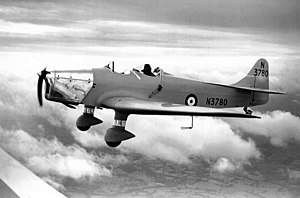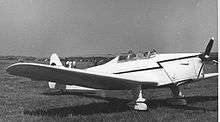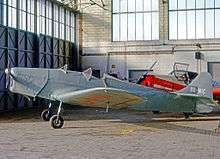Miles Magister
The Miles M.14 Magister is a British two-seat monoplane basic trainer aircraft built by the Miles Aircraft for the Royal Air Force and Fleet Air Arm. Affectionately known as the Maggie, the Magister was based on Miles' civilian Hawk Major and Hawk Trainer and was the first monoplane designed specifically as a trainer for the RAF. As a low-wing monoplane, it was an ideal introduction to the Spitfire and Hurricane for new pilots. Its sister design, the Miles Master was an advanced trainer also built by Phillips & Powis at Woodley.
| M.14 Magister | |
|---|---|
 | |
| Role | Trainer |
| Manufacturer | Miles Aircraft |
| Designer | G.H. Miles |
| First flight | 20 March 1937 |
| Primary users | Royal Air Force Fleet Air Arm |
| Number built | 1,303 |
Design and development
The Miles M.14 was designed to meet Air Ministry Specification T.40/36 and was first flown on 20 March 1937 by F.G. Miles and then christened 'Magister'.[1] Based on Miles' Hawk Trainer, the Magister is an open-cockpit, low wing cantilever monoplane of spruce structure covered in plywood.[1] The wing centre section has no dihedral and is of constant section with outer sections having dihedral and tapering towards the tip.[2] It has a fixed tailwheel undercarriage with spats on the main wheels.[2] Split flaps are fitted as standard.[3][4] Early Magisters (including the first prototype) suffered a number of accidents when the aircraft could not be recovered from a spin. To solve this problem, the tailplane was raised by 6 inches (15 cm), anti-spin strakes fitted to the rear fuselage, and eventually, a new taller rudder. Thus modified, the aircraft became the definitive M.14A.[5]
Notwithstanding the relatively large number built, contemporary glues used to assemble the wooden aircraft have not stood the test of time and few survive today.
Operational history
Production began in October 1937 and by the start of the Second World War over 700 Magisters had entered service with RAF Elementary Flying Training Schools, eventually equipping 16 such schools as well as the Central Flying School. Large numbers of civilian Hawk Majors were also pressed into service as trainers. Production of the Magister continued until 1941 by which time 1,203 had been built by Miles and an additional 100 were built under licence in Turkey. In June 1940, as part of British anti-invasion preparations, about 15 Magisters were fitted with bomb racks for eight 25 pound bombs, with the intention of using them as light bombers in the event of an invasion; a scheme called Operation Banquet which was never put into effect.[6]


After the war many Magisters were converted for civilian uses and redesignated as the Hawk Trainer III. The 1950 Kings Cup Air Race, in which eight Hawk Trainer IIIs competed, was won by E. Day in a modified cabin version G-AKRV at 138.5 mph. At least two other aircraft were thus modified.[7]
Many Magisters were exported postwar to overseas private pilot owners and flying clubs. Countries purchasing the type included Argentina, Australia, Belgium, Denmark, Egypt, France, Iceland, Ireland, Italy, Kenya, Lebanon, Morocco, New Zealand, Portugal, South Africa, Thailand and Tunisia.
In 2009, ten Hawk Trainer IIIs were registered in the United Kingdom, of which several were airworthy.
Several ex-service Magisters are preserved and on display – including an ex-RAF example at the Imperial War Museum in the UK, and an ex-Irish Air Corps example at the National Museum of Ireland in Dublin.
Variants
- Miles M.14 Magister / Hawk Trainer III
- Initial production version.
- Miles M.14A Magister I / Hawk Trainer III
- Improved variant.
- Miles M.14B Magister II / Hawk Trainer II
- Improved variant with a 135hp Blackburn Cirrus II engine
.jpg)
Operators
- Royal Australian Air Force[8] – One aircraft.
- Belgian Air Force – One aircraft operated from 1946 to 1948.
- Estonian Air Force[8] – One aircraft
- Irish Air Corps[9] – 27 aircraft from 1939 to 1952.
- Malayan Volunteer Air Force[8]
- Royal New Zealand Air Force[8] – Two aircraft.
- Portuguese Air Force[8] – Ten aircraft.
Specifications (Miles M.14A)
Data from Miles Aircraft since 1925[10]
General characteristics
- Crew: 2
- Length: 24 ft 7.5 in (7.506 m)
- Wingspan: 33 ft 10 in (10.31 m)
- Height: 6 ft 8 in (2.03 m)
- Wing area: 176 sq ft (16.4 m2)
- Airfoil: root: Clark YH mod (19%) ; tip: Clark YH mod (9%)[11]
- Empty weight: 1,286 lb (583 kg)
- Gross weight: 1,900 lb (862 kg) normal
- 1,845 lb (837 kg) for aerobatics
- Fuel capacity: 21.5 imp gal (25.8 US gal; 98 l) ; oil 2.5 imp gal (3.0 US gal; 11 l)
- Powerplant: 1 × de Havilland Gipsy Major I 4-cylinder air-cooled inverted in-line piston engine, 130 hp (97 kW)
- Propellers: 2-bladed fixed-pitch propeller
Performance
- Maximum speed: 142 mph (229 km/h, 123 kn) at 1,000 ft (305 m)
- 140 mph (122 kn; 225 km/h) at sea level
- 130 mph (113 kn; 209 km/h) at 5,000 ft (1,524 m)
- 125 mph (109 kn; 201 km/h) at 10,000 ft (3,048 m)
- Cruise speed: 122 mph (196 km/h, 106 kn)
- Stall speed: 43 mph (69 km/h, 37 kn) flaps down
- 52 mph (45 kn; 84 km/h) flaps up
- Range: 367 mi (591 km, 319 nmi)
- Endurance: 3 hours
- Service ceiling: 16,500 ft (5,000 m)
- Absolute ceiling: 19,000 ft (5,791 m)
- Rate of climb: 850 ft/min (4.3 m/s)
- Wing loading: 10.7 lb/sq ft (52 kg/m2)
- Take-off run: 630 ft (192 m) in 5 mph (4.3 kn; 8.0 km/h) wind
- Take-off distance to 50 ft (15 m): 1,200 ft (366 m) in 5 mph (4.3 kn; 8.0 km/h) wind
- Landing run: 420 ft (128 m) in 5 mph (4.3 kn; 8.0 km/h) wind
- Landing distance from 50 ft (15 m): 975 ft (297 m) in 5 mph (4.3 kn; 8.0 km/h) wind
See also
Related development
Aircraft of comparable role, configuration and era
- Caudron Aiglon
- de Havilland Moth Minor
- Fairchild PT-19
- Ikarus Aero 2
- Klemm Kl 35
- PTO-4
- RWD 23
- Valmet Tuuli
- Yakovlev UT-2
Related lists
References
- Notes
- Johnson Aeroplane Monthly March 1980, pp. 154–155.
- Flight 12 June 1941, p. h.
- Johnson Aeroplane Monthly March 1980, p. 154.
- Thetford 1957, p. 334.
- Johnson Aeroplane Monthly March 1980, pp. 155–156.
- Mondey, David (1994), The Hamlyn Concise Guide to British Aircraft of World War II, Chancellor Press, ISBN 978-1851526680 (p. 168)
- Jackson 1974, p. 69.
- Amos 2009, pp. 367–406
- MacCarron 1996, p. 138
- Brown, Don L. (1970). Miles Aircraft since 1925 (1st ed.). London: Putnam & Company Ltd. pp. 135–146. ISBN 0-370-00127-3.
- Lednicer, David. "The Incomplete Guide to Airfoil Usage". m-selig.ae.illinois.edu. Retrieved 16 April 2019.
- Bibliography
- Amos, Peter. Miles Aircraft – The early years. Tonbridge: Air-Britain, 2009. ISBN 978-0-85130-410-6.
- Amos, Peter. Miles Aircraft – The Wartime Years 1939 to 1945. Tonbridge: Air-Britain, 2012. ISBN 978 0 85130 430 4.
- "Friend or Foe: Two Familiar British Trainers: Tiger Moth and Miles Magister". Flight, Vol. XXXIX, No. 1694, 12 June 1941. p. h.
- Green, William and Gerald Pollinger. The Aircraft of the World. London: Macdonald, 1955.
- Jackson, A.J. British Civil Aircraft since 1919, Volume 2. London: Putnam, 1973. ISBN 0-370-10010-7.
- Johnson, Graham H.R. "RAF Piston Trainers No. 7: Miles M.14 Magister". Aeroplane Monthly, Vol. 8 No. 3, March 1980. pp. 154–161.
- Lukins, A.H. and D.A. Russell. The Book of Miles Aircraft. Leicester, UK: The Harborough Publishing Company Ltd., 1946.
- MacCarron, Donal. Wings Over Ireland. Leicester: Midland Publishing, 1996. ISBN 1-85780-057-5.
- Ovčáčík, Michal and Karel Susa. Miles Magister: M.14, M14A, M14B. Prague: Mark I Ltd., 2001. ISBN 80-902559-4-9.
- Simpson, Rod The Archive Photographs Series Miles Aircraft Stroud: Chalford Publishing Ltd, 1998.
- Swanborough, Gordon. British Aircraft at War, 1939–1945. East Sussex, UK: HPC Publishing, 1997. ISBN 0-9531421-0-8.
- Temple, Julian C. Wings over Woodley – The Story of Miles Aircraft & and the Adwest Group Bourne End: Aston Publications, 1987.
- Thetford, Owen. Aircraft of the Royal Air Force 1918–57. London: Putnam, 1957.
External links
| Wikimedia Commons has media related to Miles Magister. |
- Miles Magister and Miles Hawk Trainer IIIs – British Aircraft of World War II
- Miles Magister Video